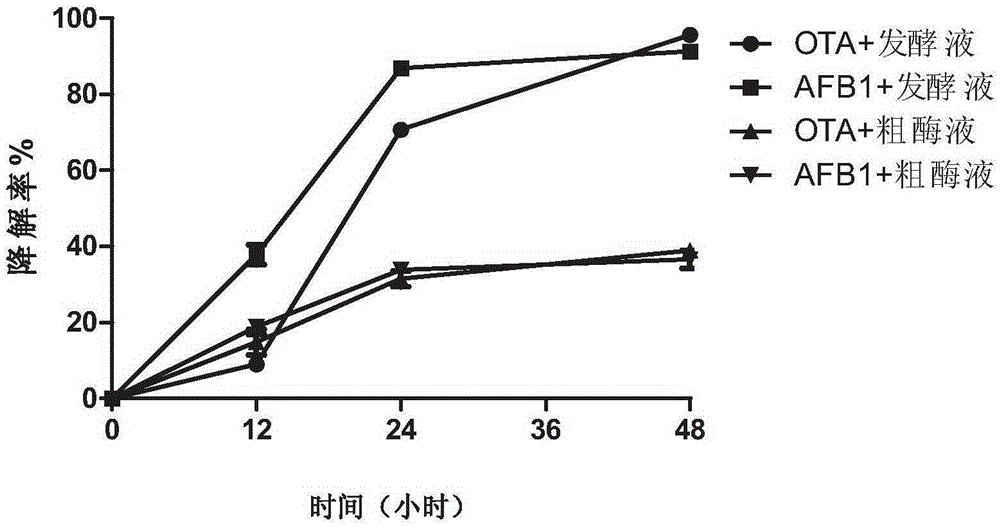Spring water monoucleosis for degrading alflatoxin B1 and ochratoxin A and application of spring water mononucleosis
A kind of spring monas, aflatoxin technology, applied in the direction of bacteria, microbe-based methods, biochemical equipment and methods, etc., can solve the problems of no substantial detoxification significance, rare reports, etc.
- Summary
- Abstract
- Description
- Claims
- Application Information
AI Technical Summary
Problems solved by technology
Method used
Image
Examples
Embodiment 1
[0022] Example 1 Screening, identification and cultivation of aflatoxin B1 and ochratoxin A degrading bacteria
[0023] 1. Screening of strains
[0024] The samples were collected from soil heavily contaminated by polycyclic aromatic hydrocarbons (near oil refineries and auto repair shops) and moldy foods heavily contaminated by mycotoxins. Take 0.5 g of the collected sample and add it to 150 mL of enrichment medium (the content of OTA and AFB1 are each about 20 μg / L), and enrich and culture in a constant temperature incubator at 30° C. for 7 days. After the first enrichment culture, take 5mL enrichment culture solution and inoculate 150mL fresh OTA and AFB1 enrichment medium, increase the concentration of OTA and AFB1 to 30μg / L, and continue enrichment culture under the same conditions 7 day. Complete the third enrichment culture experiment with the same enrichment method, and increase the concentration of OTA and AFB1 to 50μg / L. After the enrichment culture is completed, the e...
Embodiment 2
[0034] Example 2 Detecting the degradation characteristics of strain CW282 by high performance liquid chromatography
[0035] Degradation dynamic detection of degrading strain: The degrading strain CW282 was continuously activated on the most suitable solid medium for 2 generations, inoculated into 4mL liquid medium and cultivated overnight to obtain fresh bacterial liquid. Inoculate 50μL of fresh bacterial solution into 4mL OTA test medium (containing 20.0μg / LOTA) and AFB1 test medium (containing 20.0μg / LAFB1) respectively, and culture the inoculated test tube with shaking for 0h, 12h, 24h and 48h, each degraded The experiment is set to 3 replicates. E.coli K12 was used as a negative control strain. After the incubation, mix well, centrifuge at 8000r / min for 10 minutes, and collect the supernatant and the bacterial pellet.
[0036] The degraded supernatant was passed through the OTA immunoaffinity column and the AFB1 immunoaffinity column, respectively, and eluted with methanol....
Embodiment 3
[0041] Example 3 Application of strain CW282 in detoxification treatment of corn soybean meal feed
[0042] 1. Experimental materials
[0043] Strain activation medium I: Tryptone 17.0g / L, Soy peptone 3.0g / L, Glucose 2.5g / L, NaCl5.0g / L, K 2 HPO 4 2.5g / L, agar 20.0g / L.
[0044] Strain activation medium II: peptone 5.0g / L, beef extract 30.0g / L, NaCl5.0g / L, pH7.0-7.2.
[0045] The above-mentioned medium was autoclaved at 120°C for 15 minutes, and the experimental feed was corn soybean meal type diet.
[0046] 2. Experimental method
[0047] Add an appropriate amount of OTA and AFB1 standard stock solution to 50mL of phosphate buffer, and immediately pour it into 100g of the crushed feed sample after mixing. Stir evenly to make the final concentration of OTA and AFB1 reach 40.0μg / kg. Dry in a cool, ventilated place for later use. Continuously activate the tested strains on the solid activation medium I for 2 generations, inoculate the activated strains in 150 mL of liquid activation medium...
PUM
 Login to View More
Login to View More Abstract
Description
Claims
Application Information
 Login to View More
Login to View More - Generate Ideas
- Intellectual Property
- Life Sciences
- Materials
- Tech Scout
- Unparalleled Data Quality
- Higher Quality Content
- 60% Fewer Hallucinations
Browse by: Latest US Patents, China's latest patents, Technical Efficacy Thesaurus, Application Domain, Technology Topic, Popular Technical Reports.
© 2025 PatSnap. All rights reserved.Legal|Privacy policy|Modern Slavery Act Transparency Statement|Sitemap|About US| Contact US: help@patsnap.com



